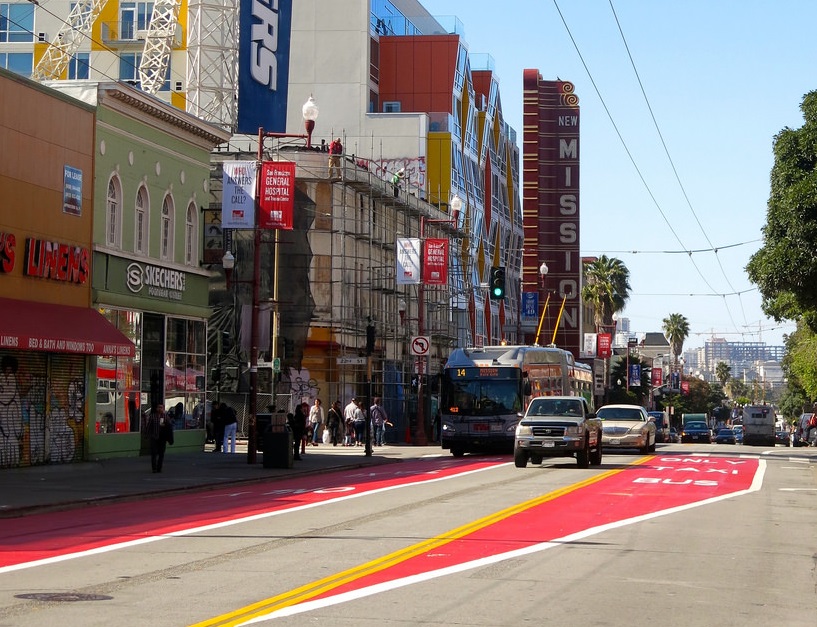
Photo: torbakhopper/Flickr
The Mission Street Rapid Project will see a few changes approved by the SFMTA Board of Directors this week to help vehicle traffic flow more smoothly through the area (see more details on that below).
These modifications, as well as the original street design, were developed based on extensive feedback from the community we gathered through a series of efforts before and after the project rolled out.
The original changes, which included red transit-only lanes and required right turns to make Mission safer and work better for Muni, were developed after nearly a year of community outreach (.pdf) in 2015, which included several open houses, door-to-door canvassing of every merchant along the project corridor, dozens of meetings with over 30 different neighborhood groups and several multilingual surveys conducted online and in person.
This spring, after the red paint on Mission’s new transit-only lanes had dried, we went back out to the community to discuss how the new street design was perceived by residents, Muni riders, motorists and others who use the street.
Over three days in late June and early July, we conducted “intercept” surveys (.pdf) on Mission Street to get feedback from people on Mission Street – no matter what transportation mode they used.
Of the roughly 1,400 people who responded, 56 percent were Hispanic, 22 percent White/Caucasian, 13 percent Asian/Pacific Islander, 7 percent Black/African-American and 2 percent identified as other. Of those who reported their household income, 44 percent earned less than $25,000 and 30 percent earned less than $50,000.
What We Heard on Mission Street
Overall, we heard a lot of positive feedback from people who visit Mission Street often. Here are some key findings:
- Over 75 percent of respondents (and 84 percent of identified Muni riders) supported or felt neutral about the project.
- Nearly two-thirds said that the transit and roadway changes either maintained or improved access to local businesses.
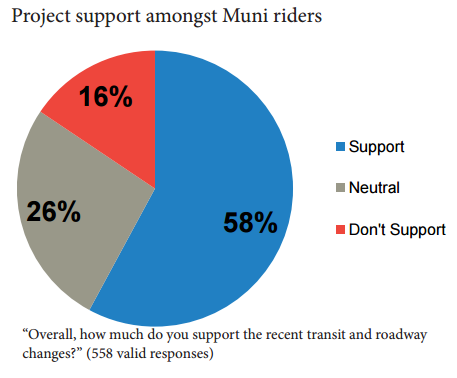
- Eighty-four percent of people arrived on Mission Street by transit or by walking.
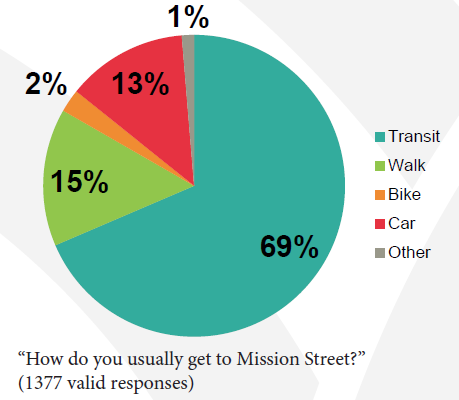
- Most people on Mission Street lived in the neighborhood, or were there primarily to shop or work.
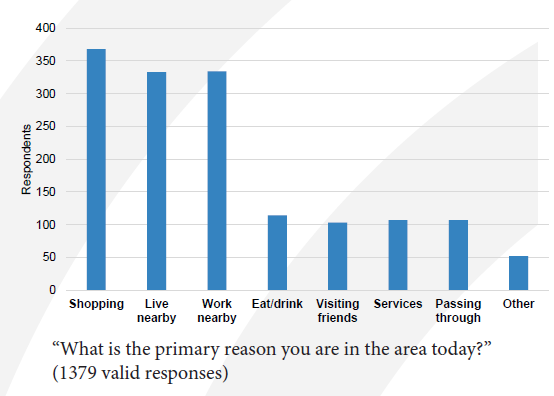
- Sixty-one percent said they visit the Mission just as often (17 percent said “more often”) than before the changes went into place.
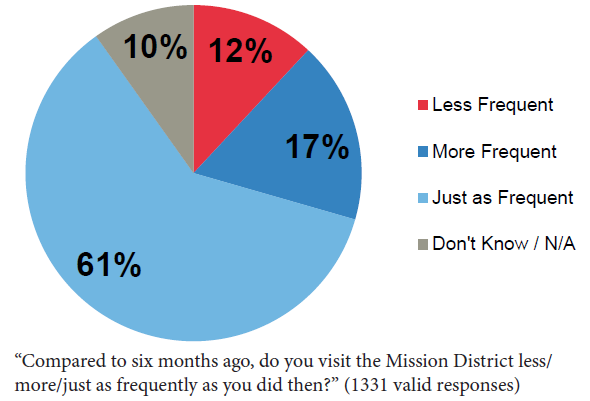
Mission Street is Safer, and Muni is More Reliable
Making Mission Street safer was one of our key goals. We were pleased to find that since the changes rolled out:
- Collisions involving Muni buses have dropped by 85 percent.
- Three-quarters of people said they feel safer on Mission.
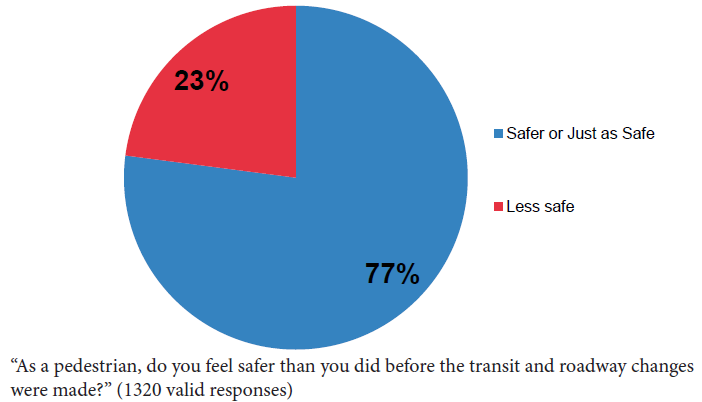
Muni is also moving faster on Mission Street – and riders said they can tell:
- Two-thirds of riders said their trip on Muni is quicker and more reliable.
- Muni buses are traveling through the area about two minutes faster, on average.
- On average, people said they perceive the ride to be 10 minutes faster.
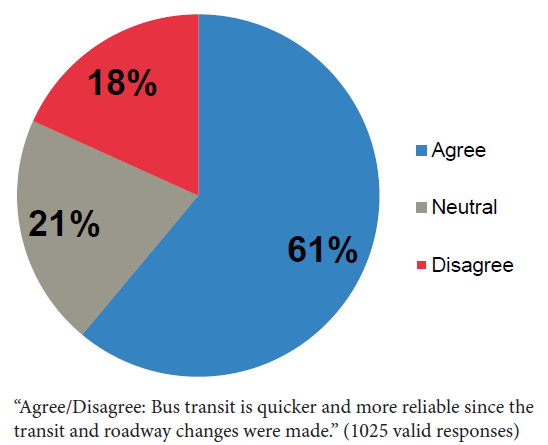
Other Outreach on Mission
In addition to conducting surveys, we provided other opportunities to weigh in on the changes on Mission. We held a town hall with more than 150 attendees at the Mission Cultural Center to share feedback and held small group meetings with community leaders and transit riders to understand how the project has affected various groups. We also talked to about 400 merchants (.pdf) in the Mission Street project area to hear their thoughts on the street changes in April when the project was under construction. Just over 20 percent expressed concern that the changes were negatively affecting sales. We visited merchants again more recently to continue discussions about their perceptions of the changes after they were finished. Nearly all mentioned that more parking could address the drop in sales.
We’ve Listened: Project Changes on the Way
Balancing the needs of such a diverse community is an ongoing effort. That’s why we proposed the following changes to the Mission Street project, based on all of the great feedback we’ve received.
Here are the changes on the way for the Mission Street Rapid Project:
- Two of the required right turns on Mission will be removed at 26th and 22nd streets.
- This will allow people to drive four blocks on Mission before they encounter a required right turn, making it easier for them to park near businesses. We expect this change to improve traffic flow without increasing through-traffic delaying Muni riders.
- This will allow people to drive four blocks on Mission before they encounter a required right turn, making it easier for them to park near businesses. We expect this change to improve traffic flow without increasing through-traffic delaying Muni riders.
- The southbound (outbound) stop at Cortland Avenue will be moved to the near side of the intersection.
- This will make it easier for Muni riders to board at the extended sidewalk.
- This will make it easier for Muni riders to board at the extended sidewalk.
- Taxis will be exempted from the “no left turn” restriction at Mission and 21st streets.
- This exemption will provide more flexibility for taxis to reach their destinations.
Moving forward, we will continue to monitor Mission Street to see if there are further opportunities for tweaks we can make to ensure the street works for everyone.